Feb. 4, 2013 — There are few people more qualified than Jerry Ross to describe what it is like to launch into space.
Retired after three decades as a NASA astronaut, Ross flew into space a record seven times. Over the course of his nearly 1,400 hours orbiting Earth — including almost 60 hours performing spacewalks — Ross helped save and deploy one of NASA's four "great observatories," worked at two space stations, and served the U.S. Department of Defense on a classified shuttle mission that he still cannot talk about to this day.
Ross recounts his experiences in his new autobiography, "Spacewalker : My Journey in Space and Faith as NASA's Record-Setting Frequent Flyer" (Purdue University Press, 2013), co-authored with John Norberg.
: My Journey in Space and Faith as NASA's Record-Setting Frequent Flyer" (Purdue University Press, 2013), co-authored with John Norberg.
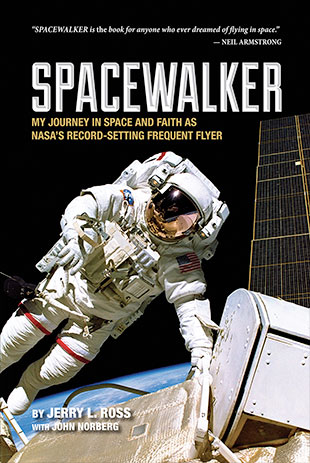
Front cover of "Spacewalker: My Journey in Space and Faith as NASA's Record-Setting Frequent Flyer" (Purdue University Press) |
collectSPACE.com recently spoke with Ross about writing "Spacewalker," his hopes for the book and his thoughts on the next generation of astronauts who will follow him into space, including perhaps his daughter.
collectSPACE (cS): What motivated you to write a book?
Jerry Ross: When I was down at the Cape, quite a few times while waiting for launches both as the leader of the 'Cape Crusaders' and then when I went back as the head of the VITT [Vehicle Integration Test Team], we'd have some periods of time waiting for something to happen and guys would kind of congregate around my office and we'd all tell stories. For years, the guys would tell me, 'Oh, that is a great story! You ought to write a book.'
I always kind of somehow wanted to document what I had done in the space program, partly for my granddaughters who are too young to have experienced much about my flights at all. In 1998, I started getting into genealogy and that gave me a very good appreciation for people of earlier generations documenting things for following descendants.
So I ultimately decided before I retired that I would at least test the waters and see what it was like, if I could find somebody who would publish the book for me and things like that. Ultimately, it led to Purdue University. They were interested in publishing the book and helped provide John Norberg to be co-author with me and off and running we were.
I guess there's one other piece of the puzzle to it, too. My entire career as an astronaut, they sent me out on public affairs types of appearances all the time. And I tried to concentrate on going to schools as opposed to Rotary and things like that. I wanted to try to excite young people about figuring out what their god-given talents were, then make plans for themselves based on those talents, and how best to then hone those skills, not only for their own welfare but the betterment of mankind.
So that theme runs throughout the length of the book. It is something I hope parents will read and either talk to their kids about what I say or encourage the young people to read the book for themselves.
cS: Speaking about exciting youth about space, you write in "Spacewalker" about your own interest in space starting at a young age. They say that astronauts either know they want to fly in space their entire lives or end up doing so as a result of their career leading them to the opportunity. No one decides midlife to be an astronaut. Is that consistent with what you experienced in the NASA corps?
Ross: I had a lot of friends all throughout my career who had very similar experiences to me in terms of at a very young age being excited about flying and then eventually about the space program. I wasn't as excited about flying as I was excited about getting into the space program.
Initially, when I first decided to go to Purdue University to be an engineer to get into the space program, the term 'astronaut' was not even being used. I am sure it had been coined and it was around a long time, but it wasn't being used.
My goals initially were to get into the space program as an engineer and get my hands on the hardware and help to launch things. But as time went on and as we started to launch men into space, and as my career progressed and my education progressed, I saw and purposely followed as close as I could to the footsteps of the original astronauts and the subsequent men who were hired. That was one of the major reasons I went to test pilot school.
I entered the Air Force the same year they started building the B-1 and NASA started building the shuttle. And they announced that they were going to have this category of astronauts called 'mission specialists' who could fly on the vehicle. My rationale was, so NASA originally wanted to hire test pilots for their earlier programs and now they've got this new program coming along and this new mission specialist category, it sure seems like engineers who have been through test pilot school and have become flight test engineers would fill a lot of squares, which NASA would be looking to include into their mission specialist category. So that was how I entered my career path.
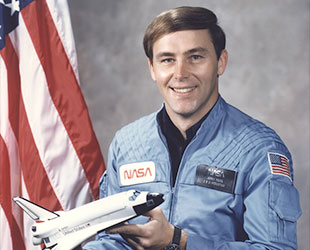
Jerry Ross' 1981 original NASA astronaut portrait. (NASA) |
There were some people in the astronaut classes that I knew who applied for the program kind of on a whim, just to see if they could get another star, if you will, in their vitae. But very few of those stayed in the program very long. Most of those were a one or two-time flyer and then they were out of there because they weren't dedicated to getting into the astronaut office and helping to push back the frontiers for knowledge and explore space. They were more of "Can I reach the peak of this mountain?"
Most of the people who stayed with the program for long periods of time and then basically dedicated their lives were the ones like myself, who had been desiring to be in the program and flying for basically their whole lives.
cS: Do you think space exploration is still exciting enough in of itself to interest today's youth?
Ross: The excitement has in some ways been taken out because it's a "been there, done that" type of thing and all the instantness of the current everyday life is what has been spawned from what we have done earlier.
A lot of things of magic — the wonder of a black and white TV you see for the first time or watching a rocket launch for the first time — that's all gone. It's commonplace, it's everyday, you can almost say it is boring to people. And that's too bad. It really is.
cS: How important was the influence and inspiration of the original astronauts to your own career in space?
Ross: Even if we never had flown in space, ever, I still would have wanted to be involved in the space program and help launch satellites and rockets. Had we had never progressed beyond that, I would have still endeavored to get my engineering degree at Purdue to get involved in our country's space program.
But as things matured and they started to launch men into space, essentially at the time I was graduating from high school and started to realize the fact I was going to make it into engineering and hopefully graduate and therefore have the credentials to get into the space program, then my focus started to alter some. Especially, as I explain the book, as NASA's astronaut classes started to include people who were not military test pilots. They started to include scientists and engineers.
And of course, when NASA announced the space shuttle program and the fact they were going to have an entirely new category of astronauts who would be qualified solely upon their academics and work experience and did not include flying, that was a great opportunity for me. The timing was just perfect to get into the program upon those type of credentials and getting in on the ground floor for being a mission specialist.
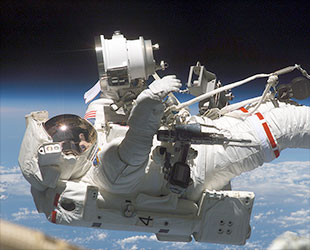
Jerry Ross, as seen outside the International Space Station (ISS) during ninth and final spacewalk in April 2002. (NASA) |
To me, the mission specialist category was the most desirable one, anyhow. Even if I had been a qualified test pilot, I would have rather done what I got to do than to be one of the front seaters in the space shuttle. In fact, I had several test pilot type people in the astronaut office, who were — though they wouldn't totally admit it — envious of what the mission specialist category people got to do on the flights, including especially the spacewalks but also the variety of things we got to do on each mission was a lot different from what they got to experience sitting in the front two seats.
cS: You set a record becoming the first NASA astronaut to fly seven times to space, an achievement matched by only one other. How aware were you that you would break the record as you approached seven flights?
Ross: I never went into it to break any records. Records are something that I think is a cause of what you do.
In fact, as far as I am concerned, what John Young was able to accomplish in his career will never be surpassed. Maybe the number [of launches] has been surpassed, but just the things he did, when he did them and the style in which he did them, it's insurmountable.
Certainly I was cognizant of setting a record — you can't hardly not be cognizant of it because of the press and everybody else who tracked such things and it ends up in articles.
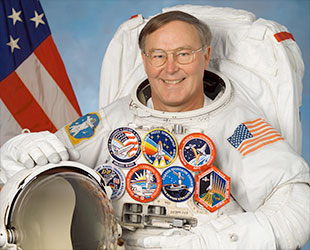
Jerry Ross poses for his final NASA astronaut portrait wearing the mission patches from his record seven spaceflights. (NASA) |
I personally thought that seven was a good start. I thought 10 was a nice round number, something that I was hoping to achieve — not because it was a higher number, but because it meant I would have more opportunities to fly in space and more opportunities to enjoy that experience with other crew members and to accomplish more in terms of the exploration of space and building the space station.
Frankly, I believe, and am disappointed we aren't breaking records. Because if we were breaking our records then we're progressing further into space and that's what I want to see.
cS: Looking back, do you have a favorite mission among your seven spaceflights?
Ross: I've been asked that a lot of times and I talk about it in the book. It is kind of like asking a mother which one of her seven kids is her favorite. I think most mothers would say that they are all her favorite.
I guess I have to say that the first flight is always going to have a very good place in my heart, just due to the fact that it was the first. It also got me out the door on two spacewalks. So from that perspective, it was certainly a very high point in my career.
I think from there, each one had some good points. The second [mission] I can't really talk about, it was a neat flight. On the third flight I helped fix the Compton Gamma Ray Observatory, otherwise it would have been $60 to $70 million worth of space junk.
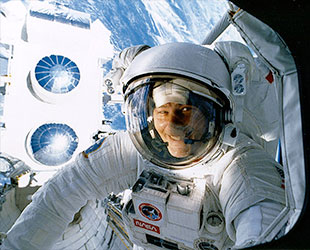
Jerry Ross looks into the aft flight deck windows of space shuttle Atlantis after freeing an antenna on NASA's Compton Gamma Ray Observatory visible in the background. (NASA) |
On the fourth flight, we got incredibly neat science from almost 90 different experiments over 10 days. On the fifth flight, we got to go to the Mir station. It was an incredible crew and experience.
The sixth flight, it would probably have to be another one that had to be ranked pretty high: it was the start of the assembly of the International Space Station. And on the seventh flight, getting to do two more spacewalks to do assembly of the station and start to see it grow and have permanent inhabitants living on it.
All were really cool and they were a nice mix. There wasn't any repetitiveness to any of the flights.
cS: "Spacewalker" was released on Jan. 31, between the anniversaries of the losses of the shuttles Challenger and Columbia on Jan. 28 and Feb. 1, respectively. You write about both tragedies. Was the timing purposeful?
Ross: Originally, Purdue Press was going to release the book before Christmas. Then, for some internal reasons that I am not sure of exactly but I think they had internal pressures — other books lined up in the queue, so they decided to do this book justice they were going to push it off into January.
Frankly, when they said they wanted to push it off into January, it was my recommendation that we went to Jan. 31. And it was not with respect to any of the manned flight incidents that we had. In fact, had I thought about it, I might have backed off from the 31st of January.
The 31st of January of this year happens to be the 55th anniversary of Explorer 1, and that is why I suggested that date.
cS: You mentioned wanting to fly (at least) 10 flights. Had Challenger and Columbia not been lost, would you still be active in the program?
Ross: At this point, I would not be in the program, but I'd have hoped that I was just leaving it after a very active flying career up until the point that I left.
If we hadn't had those accidents, certainly there were five or six years in the shuttle program that were lost with the standdowns after Challenger and Columbia when we would have continued to fly. If we hadn't had the problems, we probably would have continued to fly the shuttle and so that would have been another 10 or so years at the end of my career that we would have been flying.
So that was another 15 years worth of active flying of the shuttle program that I would have hopefully been able to participate in and I would have delighted in that. I would have hoped to have been able to fly again once every two or three years, giving me a lot more flight experiences that I would have reveled in, frankly.
cS: With regards to flying and the shuttle tragedies, was it more a challenge for you personally to deal with the loss of Challenger as you were still on the flight roster in 1986?
Ross: I think as to the losses themselves, with respect to whether I was flying, that doesn't have any significance. The impacts were terrible and they were punches to the gut in both cases. I had friends flying on both vehicles and it was very difficult to take.
I think the major difference for me, personally, was on the Challenger accident I was relegated to not being allowed to participate in the recovery and trying to do something about what happened. Since I didn't get the chance to do any active search for the hardware or trying to determine what the problems were, I anointed myself as one of the people who should be going to all of the memorial services and try to do what I could to help comfort the families. And that was frustrating, because I am a guy who wants to get in there and help fix, help do things.
But on Columbia, I was on the rapid response team. I was there that day, I helped take care of the families and send them home, then I went off to Shreveport, Louisiana that night and the next day, the day after the accident, I was in Luftkin, helping to pull together the plan on how to search for the debris. I helped lead that effort for the next month.
So it was a totally different experience in what I did after the accident. I have to tell you, neither one of them was a good time in terms of loss of friends, but being involved in the recovery of Columbia debris and helping to get NASA back on its feet to press on with the exploration of space was a much better feeling.
And the teamwork we experienced up in East Texas with the tremendous collection of capabilities and people and resources was a very good feeling from the perspective of working together with so many people from all around the country to get the job done.
cS: In hindsight, given the several year gap we are facing in human spaceflight capability now, do you think the end of the space shuttle program came too soon?
Ross: I don't think the decision to shut down the shuttle program was premature. I think the failure of President [G. W.] Bush and the Congresses during the era in which that decision was made when we were starting up the following programs, there was a failure to provide enough resources to get those programs off on the right foot, which almost immediately started to push the available dates for us to start flying those vehicles out.
Any, of course, any time you do that, you have a standing army in place to support the programs, which pushes up the overall cost of the program. We did that for several years and by the time the current administration came in, they had a different plan and it made it very easy to axe the Constellation program because there had been delays and overruns.
Had we had a little bit stronger monetary support in those first couple years of the new program, we'd have been to the point where we would have been very close to flying and we'd have been much closer to the original budget. I believe we wouldn't have the problems we are having now.
cS: Had the proper funding been there at the start and we were today closer to flying a new vehicle, would you have still left the program when you did?
Ross: Since I wasn't flying any more — and by the way, that was not my decision; that was based on the limited number of flights and the number of rookies who had yet to fly — I would have hung up my hat anyhow at the end of the shuttle program.
The primary reason I stuck around those last years was to do what I could do to help friends fly safely on the shuttle and once there was a termination established, I wanted to stick around to see the shuttle program to its conclusion before I exited the stage.
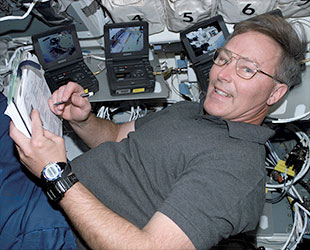
Jerry Ross looks over a procedures checklist on the flight deck of the space shuttle Atlantis during the STS-110 mission. (NASA) |
cS: Were you there to see any of the now-retired shuttles be delivered to their respective museum display homes?
Ross: I didn't get to participate in any of those, including the delivery of my favorite, Atlantis, to its new facility at the Cape. I did see Endeavour here [in Houston] on the flight line when it came through Ellington Field [on the way to California] but I have not been to any of the museums to see them.
cS: Is seeing Atlantis or the other shuttles in museums an experience you do not relish?
Ross: No, I fully agreed with the termination of the shuttle program. The more we flew them, the more things that we learned about them, the harder it was to get them to fly safely.
And frankly, I believed it was only a matter of time if we continued to fly before we would have lost another vehicle and crew. I talk about that some in the book. I had a pit in my gut during every flight because of my concerns for my friends flying.
cS: But it is somewhat surreal to know the spacecraft you flew are now retired in museums?
Ross: I guess there is some surrealism to it. It is hard to believe that an era has passed and something that you so proudly worked on and so diligently worked on is now a part of history.
But I have experienced that before throughout my career. There is a B-1 in a museum at [Wright-Patterson Air Force Base in Dayton, Ohio] and a lot of the planes that I flew in the Air Force are now probably beer cans wrapped in the aluminum that has been recycled.
Throughout a career, it is something that you experience. The longer you go, the more of that you do experience.
cS: Though you're now retired from the program, the Ross legacy as it applies to space exploration has not come to an end. As you mention in "Spacewalker," your daughter is a spacesuit engineer and in fact, you had the chance to test in space the gloves she helped design.
Ross: I think it is really cool. I think any parent is really pleased when one of their children decides that they want to follow in their footsteps and do the kinds of things that mom and dad had done. So that's very rewarding to me.
Even more rewarding was when about the time I finished flying in space, I transitioned from being known as "Jerry Ross, the astronaut" to "Jerry Ross, Amy's dad." And that is great. I mean, that is natural. That is what generational changeover should be and that was really a great feeling for me.
There's one other aspect to that: Amy was interviewed for the astronaut program. They started out with about 6,000 applicants, they narrowed it down to 400 and from that I've been told they chose about 120 for interviews. Sometime, I understand [in this month], they will down-select to the last 50 finalists and from that they will be selecting about 10-ish.
Very, very excited for her and we would be absolutely delighted if she had the opportunity and good fortune to be selected into the astronaut office. But even if she doesn't, we're still extremely proud of her accomplishments and her dedication to working at NASA and being recognized in such a nice way.
cS: So now that "Spacewalker" is on store shelves and is being read, how well do you feel it accomplishes what you set out to do when you decided to write a book?
Ross: I think it stands is a very good representation of my life and what I got a chance to do. I was very blessed in my career, in my family life and my professional life.
I hope that people will enjoy the read. I wrote it from a perspective that as they read the book it's almost like they are sitting on the couch with me and we are just talking. That was the intent of the book.
That was the way I wanted it to come across to folks and I hope that they enjoy the book. It is not a highly technical book but I hope it gives them a good feel for what made Jerry tick, and what I hope they can gain from it to maybe apply to their own lives.
I especially want the younger generations to get that part of the book, and I wanted them to experience some of the behind-the-scenes aspects of the space program, some of the fun stories and stuff like that.
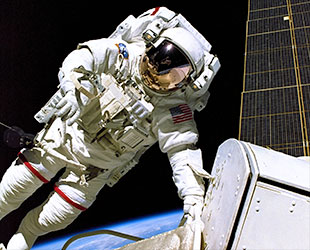
Jerry Ross spacewalks outside the then-newly-born International Space Station during the STS-88 mission in 1998. (NASA) |
And finally what it is like to launch on a half-million pound thrust rocket, to rattle your way into space, to experience zero-g and see God's beautiful creation we call Earth, to get suited up in a spacesuit, to go out on spacewalks and then come blazing back into the atmosphere to a landing.
If people can experience all those things in the book, then I have accomplished what I wanted to do.
